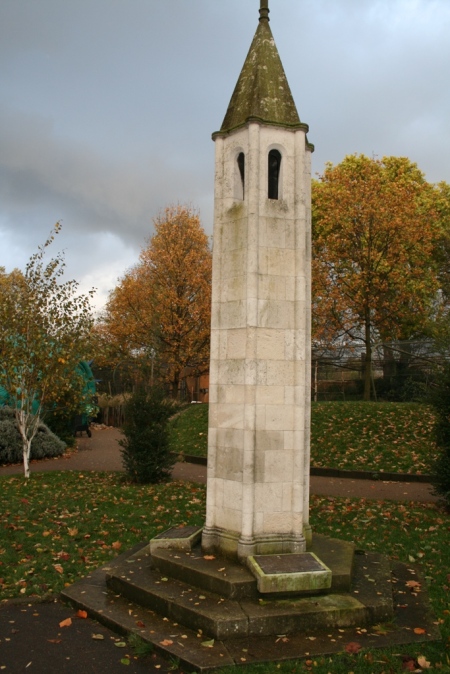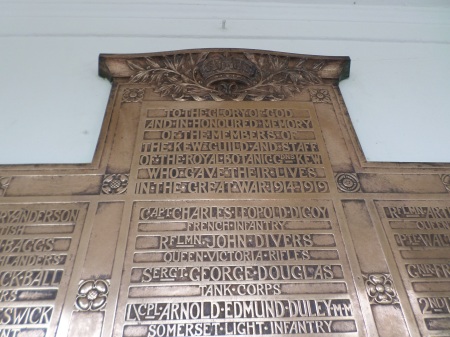
S.M. Toppin lies buried in this cemetery, an atmospheric photo showing only a few of the 9901 WW1 graves at Lijssenthoek Cemetery, Belgium. (Image http://www.cwgc.org)
24 September 1917 – Major Sidney Miles Toppin MC, FLS
Botanist and plant collector Major Sidney Miles Toppin was killed aged 39 near Ypres on 24 September 1917 as part of the Battle of Passchendaele. He left a widow Viva and infant daughter.

Major Toppin’s headstone ” Faithful unto Death”, Lijssenthoek Military Cemetery (Image: Lives of The First World War / TWGPP)
Major S.M. Toppin is buried in grave XXIV. G. 6, Lijssenthoek Military Cemetery, Poperinge, Flanders, Belgium, a cemetery linked to Casualty Clearing Stations close to the front but out of the range of German Artillery.

Major S. M. Toppin MC (IWM collection HU119197)
Born on 12 June 1875 (or 1878) in Clonmel in Ireland, he was the younger son of Major General J.M. Toppin, Royal Irish Regiment. After education at Clifton College and Gonville and Caius College Cambridge where he studied for a medical degree, he was offered a Commission in the Royal Artillery from 1900.
He served in India (Chitral), along with mountain batteries in Afghanistan, Burma and Egypt. This gave him ample opportunity to collect plants and send them back to the herbarium at Royal Botanic Gardens Kew.
He served in WW1 with the 151st Heavy Battery, Royal Garrison Artillery.
On a visit home in 1914, he married Viva before serving in Ireland and France during the early weeks of the war. “A guard of honour of Garrison Artillery gunners formed an arch with their bayonets …” His brother Harry S Toppin, also FLS and plant collector, was already mobilised and unable to attend.
He was mentioned in dispatches and awarded the MC Military Cross at Loos in 1915.
..

Report on Toppin’s wedding August 1914 (source: Lives of the First World War website) Wedding 20 Aug 1914, clipping from the Isle of Wight County Press, 22 August 1914
He is listed on the CWGC website as the son of Major-General James Morris Toppin and Mrs. J. Toppin, of Blacklands Park, Wilts; he was the husband of Viva Toppin, of Rose Bank, Sandown, Isle of Wight.
He and his brother are also remembered on the war memorial at All Saints Branksome Park, Bournemouth where they once lived.

Sidney’s brother Harry Stanley Toppin (IWM HU119196)
..

Harry Stanley Toppin (IWM Source)
More about his links with Kew Gardens, herbarium specimens and plant hunting sent back to Kew and his brother killed in 1914
Sidney’s herbarium specimens including Impatiens were bequeathed to Royal Botanic Gardens Kew. The listing for Sidney Miles Toppin (1878-1917) on the Irish botanist section of R. Lloyd Praeger, W.Tempest, Dundalgan Press, Dundalk, 1949 available online
“S. M. Toppin … collected plants in Chitral and Burma and a paper of his on “Balsams of Chitral” was published in the Kew Bulletin, 1920.
Dunn named Impatiens Toppinii after him”
(Sources: Britten & Boulger, Biog ed. 2, 302).
This Impatiens Toppinii appears now to be a disputed name.
There are several scanned examples online at the JStor Global plants section website of these herbarium sheets and accompanying letters from his mother Janie Toppin to contacts at Kew on behalf of both H.S. Toppin (who collected specimens in Peru) and S.M. Toppin who collected mostly in Myanmar (Burma). These specimens that Toppin collected can be seen at
http://plants.jstor.org/stable/10.5555/al.ap.visual.kldc12382
More about the lost Fellows of the Linnaean Society in WW1
https://worldwarzoogardener1939.wordpress.com/2013/09/11/lost-fellows-the-linnean-society-roll-of-honour-1914-1918/
More about Lost gardeners and naturalists in Passchendaele WW1
https://worldwarzoogardener1939.wordpress.com/2017/07/30/lost-gardeners-and-zoo-staff-during-passchendaele-1917-ww1/
Sidney Toppin FLS and family, remembered 100 years on, 24 September 1917.
Blog posted by Mark Norris, World War Zoo Gardens project, 24 September 2017






 .
.

 .
.




















